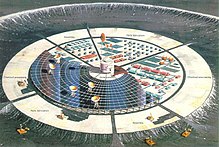Von Neumann probe
The Von Neumann probe is a hypothetical concept for self-replicating spaceships based on the idea of self-reproducing automata from mathematician John von Neumann . It is used in science fiction and has been the subject of speculative considerations about extraterrestrial civilizations .
history
The reason for the naming is the title of the book Theory of Self-Reproducing Automata by John von Neumann and Arthur W. Burks , whereby von Neumann himself did not suggest the use of such machines in space research. A Von Neumann probe is characterized by the fact that it can produce an exact copy of itself without human intervention , which in turn is able to copy itself exactly. So it is a kind of “machine single cell ”. According to this scenario, a single Von Neumann probe will be launched to the nearest solar system , where it will make at least two copies of itself that will advance further into space.
The American physicist Robert A. Freitas Jr. published a study in 1980 with the title A Self-Reproducing Interstellar Probe . He studied in a scenario in which a spacecraft a "SEED" (English. Seeds ) brings mentioned apparatus in another solar system. Here, SEED is building a factory complex called "FACTORY" on a small moon, which will then manufacture new SEED equipment and the drive system for it .
Von Neumann probes and the Fermi paradox
In 1981, Frank J. Tipler used the hypothetical probes for his argument against the existence of extraterrestrial civilizations: If such civilizations existed, at the known, old age of the universe they could have spread everywhere using self-replicating probes (Tipler's reformulation of the Fermi paradox ). Carl Sagan and William Newman opposed that intelligent civilizations had to refrain from building the Von Neumann probes in order to prevent these probes from uncontrollably consuming all available resources. Freitas is of the opinion that the reproductive speed of the probes assumed by Tipler and especially Sagan is far exaggerated and that their conclusions could not be drawn under realistic conditions. But speaks against it: Even if a Von Neumann probe could only double every 100 years, 2 100 = 1.268 · 10 30 Von Neumann probes could arise in 10,000 years . In addition, all individuals of all civilizations are unlikely to be cautious and benevolent at all times.
In the solar system to which the earth belongs, many extraterrestrial Von Neumann probes could exist today undetected - and undetectable for the existing technology on earth.
Von Neumann probes in fiction
In the science fiction series Stargate, there is a slightly modified version of this theory, the replicators. Furthermore, the book I am many by Dennis E. Taylor and its sequels deals with the topic of space exploration using Von Neumann probes from the perspective of the probes themselves. You can also find them in the novel Lord of all things by Andreas Eschbach .
See also
Individual evidence
- ↑ A Self-Reproducing Interstellar Probe
- ^ "Extraterrestrial Beings Do Not Exist", Quarterly Journal of the Royal Astronomical Society Vol. 21, No. 267 (1981)
- ^ Sagan, Carl and Newman, William, "The Solipsist Approach to Extraterrestrial Intelligence," Quarterly Journal of the Royal Astronomical Society , Vol. 24, No. 113 (1983)
- ^ Robert A., Jr .: Extraterrestrial Intelligence in the Solar System: Resolving the Fermi Paradox . J Brit Interplanet Soc Vol. 36 (1983): pp 496-500
literature
- Michio Kaku: Visions: How Science Will Revolutionize the Twenty-first Century . Oxford University Press 1999, ISBN 0-19-288018-7 , p. 328 ( restricted online version (Google Books) )
Web links
- von Neumann probe in the Internet Encyclopedia of Science
- Gerhard Fröhlich: Techno-utopias of immortality from computer science and physics (PDF; 83 kB). In: U. Becker et al. (ed): Death and Dying in Europe . Neukirchener Verlag 1997, ISBN 3-7887-1569-3 , pp. 184-213
- Antonia J. Jones: Self-replicating probes for galactic exploration (PDF; 4.1 MB). Lecture script (Imperial College London)
- Advanced Automation for Space Missions
- von Neumann probe simulation - Java applet
